- Home
- Oliver Sacks
The River of Consciousness Page 10
The River of Consciousness Read online
Page 10
While I often mishear words, I seldom mishear music: notes, melodies, harmonies, phrasings, remain as clear and rich as they have been all my life (though I often mishear lyrics). There is clearly something about the way the brain processes music that makes it robust, even in the face of imperfect hearing, and, conversely, something about the nature of spoken language that makes it much more vulnerable to deficiencies or distortions.
Playing or even hearing music (at least traditional scored music) involves not just the analysis of tone and rhythm; it also engages one’s procedural memory and emotional centers in the brain; musical pieces are held in memory and allow anticipation.
But speech must be decoded by other systems in the brain as well, including systems for semantic memory and syntax. Speech is open, inventive, improvised; it is rich in ambiguity and meaning. There is a huge freedom in this, making spoken language almost infinitely flexible and adaptable but also vulnerable to mishearing.
Was Freud entirely wrong, then, about slips and mishearings? Of course not. He advanced fundamental considerations about wishes, fears, motives, and conflicts not present in consciousness, or thrust out of consciousness, which could color slips of the tongue, mishearings, or misreadings. But he was perhaps too insistent that misperceptions are wholly a result of unconscious motivation.
Collecting mishearings over the past few years without any explicit selection or bias, I am forced to think that Freud underestimated the power of neural mechanisms, combined with the open and unpredictable nature of language, to sabotage meaning, to generate mishearings that are irrelevant both in terms of context and of subconscious motivation.
And yet there is often a sort of style or wit—a “dash”—in these instantaneous inventions; they reflect, to some extent, one’s own interests and experiences, and I rather enjoy them. Only in the realm of mishearing—at least my mishearings—can a biography of cancer become a biography of Cantor (one of my favorite mathematicians), tarot cards turn into pteropods, a grocery bag into a poetry bag, all-or-noneness into oral numbness, a porch into a Porsche, and a mere mention of Christmas Eve a command to “Kiss my feet!”
The Creative Self
All children indulge in play, at once repetitive and imitative and, equally, exploratory and innovative. They are drawn both to the familiar and the unusual—grounding and anchoring themselves in what is known and secure, and exploring what is new and has never been experienced. Children have an elemental hunger for knowledge and understanding, for mental food and stimulation. They do not need to be told or “motivated” to explore or play, for play, like all creative or proto-creative activities, is deeply pleasurable in itself.
Both the innovative and the imitative impulses come together in pretend play, often using toys or dolls or miniature replicas of real-world objects to act out new scenarios or rehearse and replay old ones. Children are drawn to narrative, not only soliciting and enjoying stories from others, but creating them themselves. Storytelling and mythmaking are primary human activities, a fundamental way of making sense of our world.
Intelligence, imagination, talent, and creativity will get nowhere without a basis of knowledge and skills, and for this education must be sufficiently structured and focused. But an education too rigid, too formulaic, too lacking in narrative, may kill the once-active, inquisitive mind of a child. Education has to achieve a balance between structure and freedom, and each child’s needs may be extremely variable. Some young minds expand and blossom with good teaching. Other children (including some of the most creative) may be resistant to formal teaching; they are essentially autodidacts, voracious to learn and explore on their own. Most children will go through many stages in this process, needing more or less structure, more or less freedom at different periods.
Voracious assimilation, imitating various models, while not creative in itself, is often the harbinger of future creativity. Art, music, film, and literature, no less than facts and information, can provide a special sort of education, what Arnold Weinstein calls a “vicarious immersion in others’ lives, endowing us with new eyes and ears.”
For my generation, this immersion came mostly from reading. Susan Sontag, at a conference in 2002, spoke about how reading opened up the entire world to her when she was quite young, enlarging her imagination and memory far beyond the bounds of her actual, immediate personal experience. She recalled,
When I was five or six, I read Eve Curie’s biography of her mother. I read comic books, dictionaries, and encyclopedias indiscriminately, and with great pleasure….It felt like the more I took in, the stronger I was, the bigger the world got….I think I was, from the very beginning, an incredibly gifted student, an incredibly gifted learner, a champion child autodidact….Is that creative? No, it wasn’t creative…[but] it didn’t preclude becoming creative later on….I was engorging rather than making. I was a mental traveler, a mental glutton….My childhood, apart from my wretched actual life, was just a career in ecstasy.
What is especially striking about Sontag’s account (and similar accounts of proto-creativity) is the energy, the ravenous passion, the enthusiasm, the love with which the young mind turns to whatever will nourish it, seeks intellectual or other models, and hones its skills by imitation.
She assimilated a vast knowledge of other times and places, of the varieties of human nature and experience, and these perspectives played a huge part in inciting her to write herself:
I started writing when I was about seven. I started a newspaper when I was eight, which I filled with stories and poems and plays and articles, and which I used to sell to the neighbors for five cents. I’m sure it was quite banal and conventional, and simply made up of things, influenced by things, I was reading….Of course there were models, there was a pantheon of these people….If I was reading the stories of Poe, then I would write a Poe-like story….When I was ten, a long-forgotten play by Karel Čapek, R.U.R., about robots, fell into my hands, so I wrote a play about robots. But it was absolutely derivative. Whatever I saw I loved, and whatever I loved I wanted to imitate—that’s not necessarily the royal road to real innovation or creativity; neither, as I saw it, does it preclude it….I started to be a real writer at thirteen.
Sontag’s prodigious and precocious intelligence and creativity allowed her to leapfrog into “real” writing as a teenager, but for most people the period of imitation and apprenticeship, studenthood, lasts much longer. It is a time when one struggles to find one’s own powers, one’s own voice. It is a time of practice, repetition, of mastering and perfecting skills and techniques.
Some people, having undergone such an apprenticeship, may remain at the level of technical mastery without ever ascending to major creativity. And it may be difficult to judge, even at a distance, when the leap from talented but derivative work to major innovation has occurred. Where does one draw the line between influence and imitation? What distinguishes a creative assimilation, a deep intertwining of appropriation and experience, from mere mimicry?
The term “mimicry” may imply a certain consciousness or intention, but imitating, echoing, or mirroring are universal psychological (and indeed physiological) propensities that can be seen in every human being, and many animals (hence terms like “parroting” or “aping”). If one sticks one’s tongue out at a young infant, it will mirror this behavior, even before it has gained adequate control of its limbs, or has much of a body image—and such mirroring remains an important mode of learning throughout life.
Merlin Donald, in his book Origins of the Modern Mind, sees “mimetic culture” as a crucial stage in the evolution of culture and cognition. He draws a clear distinction between mimicry, imitation, and mimesis:
Mimicry is literal, an attempt to render as exact a duplicate as possible. Thus, exact reproduction of a facial expression, or exact duplication of the sound of another bird by a parrot, would constitute mimicry….Imitation is not so literal as mimicry; the offspring copying its parent’s behavior imitates, but does not mimic, th
e parent’s way of doing things….Mimesis adds a representational dimension to imitation. It usually incorporates both mimicry and imitation to a higher end, that of re-enacting and re-presenting an event or relationship.
Mimicry, Donald suggests, occurs in many animals; imitation in monkeys and apes; mimesis solely in humans. But all can coexist and overlap in us—a performance, a production, may have elements of all three.
In certain neurological conditions the powers of mimicry and reproduction may be exaggerated, or perhaps less inhibited. People with Tourette’s syndrome or autism or certain types of frontal lobe damage, for example, may be unable to inhibit an involuntary echoing or mirroring of other people’s speech or actions; they may also echo sounds, even meaningless sounds in the environment. In The Man Who Mistook His Wife for a Hat, I describe one woman with Tourette’s who, while walking down the street, would echo or imitate the “dental” grilles of cars, the gibbet-like forms of lampposts, and the gestures and walks of everyone she passed—often exaggerated in a caricature-like way.
Some autistic savants have very exceptional powers of visual imagery and reproduction. This is evident with Stephen Wiltshire, whom I describe in An Anthropologist on Mars. Stephen is a visual savant with a great gift for catching visual likenesses. It makes little difference whether he makes these from life, on the spot, or long afterwards—perception and memory, here, seem almost indistinguishable. He also has an amazing ear; when he was a child, he would echo noises and words, seemingly without any intention or any consciousness of it. When, as an adolescent, he returned from a visit to Japan, he kept emitting “Japanese” noises, babbling pseudo-Japanese, and showing “Japanese” gestures, too. He can imitate the sound of any musical instrument once he has heard it and has a very accurate musical memory. I was very struck once when, at sixteen, he sang and mimed Tom Jones’s song “It’s Not Unusual,” swinging his hips, dancing, gesticulating, and clutching an imaginary microphone to his mouth. At this age, Stephen usually displayed very little emotion and showed many of the outward manifestations of classical autism, with a skewed neck posture, tics, and indirection of gaze, but all this disappeared when he sang the Tom Jones song—so much so that I wondered whether, in some uncanny way, he had gone beyond mimicry and actually shared the emotion and sensibility of the song. I was reminded of an autistic boy I had met in Canada who knew an entire television show by heart and would “replay” this dozens of times a day, complete with all the voices and gestures, and even the sounds of applause. I felt this as a sort of automatism or superficial reproduction, but Stephen’s performance left me puzzled and pensive. Had he, unlike the Canadian boy, moved from mimicry into creativity or art? Was he consciously and intentionally sharing the emotions and sensibility of the song or merely reproducing it—or something in between?*1
Another autistic savant, José (whom I also describe in The Man Who Mistook His Wife for a Hat), was often described by the hospital staff as a sort of copying machine. This was unfair and insulting, as well as incorrect, for the retentiveness of a savant’s memory is not at all comparable to a mechanical process; there is discrimination and recognition of visual features, speech features, particularities of gesture, etc. But to some extent, the “meaning” of these is not fully incorporated, and this makes the savant memory, to the rest of us, seem comparatively mechanical.
If imitation plays a central role in the performing arts, where incessant practice, repetition, and rehearsal are essential, it is equally important in painting or composing or writing, for example. All young artists seek models in their apprentice years, models whose style, technical mastery, and innovations can teach them. Young painters may haunt the galleries of the Met or the Louvre; young composers may go to concerts or study scores. All art, in this sense, starts out as “derivative,” highly influenced by, if not a direct imitation or paraphrase of, the admired and emulated models.
When Alexander Pope was thirteen years old, he asked William Walsh, an older poet whom he admired, for advice. Walsh’s advice was that Pope should be “correct.” Pope took this to mean that he should first gain a mastery of poetic forms and techniques. To this end, in his “Imitations of English Poets,” Pope began by imitating Walsh, then Cowley, the Earl of Rochester, and more major figures like Chaucer and Spenser, as well as writing “Paraphrases,” as he called them, of Latin poets. By seventeen, he had mastered the heroic couplet and began to write his “Pastorals” and other poems, where he developed and honed his own style but contented himself with the most insipid or clichéd themes. It was only once he had established full mastery of his style and form that he started to charge it with the exquisite and sometimes terrifying products of his own imagination. For most artists, perhaps, these stages or processes overlap a good deal, but imitation and mastery of form or skills must come before major creativity.
Yet even with years of preparation and conscious mastery, great talent may or may not fulfill its seeming promise.*2 Many creators—whether they are artists, scientists, cooks, teachers, or engineers—are content, after they have achieved a level of mastery, to stay with a form, or play within its bounds, for the rest of their lives, never breaking into anything radically new. Their work may still show mastery and even virtuosity, giving great delight even if it does not take the further step into “major” creativity.
There are many examples of “minor” creativity, creativity that does not seem to change much in character after its initial expression. Arthur Conan Doyle’s 1887 A Study in Scarlet, the first of his Sherlock Holmes books, was a remarkable achievement—there had never been a “detective story” like it before.*3 The Adventures of Sherlock Holmes, five years later, was an enormous success, and Conan Doyle found himself the acclaimed writer of a potentially never-ending series. He was delighted by this but also annoyed, because he wanted to write historical novels too, but the public showed little interest in these. They wanted Holmes and more Holmes, and he had to supply it. Even after he killed Holmes off in “The Final Problem,” sending him over the Reichenbach Falls in mortal combat with Moriarty, the public insisted that he be resurrected, and so he was, in 1905, in The Return of Sherlock Holmes.
There is not much development in Holmes’s method or mind or character; he does not seem to age. Between cases, Holmes himself scarcely exists—or, rather, exists in a regressed state: scraping at his violin, shooting up cocaine, doing malodorous chemical experiments—until he is summoned to action by the next case. The stories of the 1920s could have been written in the 1890s, and those written in the 1890s would not have been out of place later. Holmes’s London is as unchanging as the man; both are depicted, brilliantly, once and for all, in the 1890s. Doyle himself, in his 1928 preface to Sherlock Holmes: The Complete Short Stories, says that the reader may read the stories “in any order.”
Why is it that of every hundred gifted young musicians who study at Juilliard or every hundred brilliant young scientists who go to work in major labs under illustrious mentors, only a handful will write memorable musical compositions or make scientific discoveries of major importance? Are the majority, despite their gifts, lacking in some further creative spark? Are they missing characteristics other than creativity that may be essential for creative achievement—such as boldness, confidence, independence of mind?
It takes a special energy, over and above one’s creative potential, a special audacity or subversiveness, to strike out in a new direction once one is settled. It is a gamble as all creative projects must be, for the new direction may not turn out to be productive at all.
Creativity involves not only years of conscious preparation and training but unconscious preparation as well. This incubation period is essential to allow the subconscious assimilation and incorporation of one’s influences and sources, to reorganize and synthesize them into something of one’s own. In Wagner’s overture to Rienzi, one can almost trace this emergence. There are echoes, imitations, paraphrases, pastiches of Rossini, Meyerbeer, Schumann, and others—all the
musical influences of his apprenticeship. And then, suddenly, astoundingly, one hears Wagner’s own voice: powerful, extraordinary (though, to my mind, horrible), a voice of genius, without precedent or antecedent. The essential element in these realms of retaining and appropriating versus assimilating and incorporating is one of depth, of meaning, of active and personal involvement.
Early in 1982, I received an unexpected packet from London containing a letter from Harold Pinter and the manuscript of a new play, A Kind of Alaska, which, he said, had been inspired by a case history of mine in Awakenings. In his letter, Pinter said that he had read my book when it originally came out in 1973 and had immediately wondered about the problems presented by a dramatic adaptation of this. But, seeing no ready solution to these problems, he had then forgotten about it. One morning eight years later, Pinter wrote, he had awoken with the first image and first words (“Something is happening”) clear and pressing in his mind. The play had then “written itself” in the days and weeks that followed.
I could not help contrasting this with a play (inspired by the same case history) which I had been sent four years earlier, where the author, in an accompanying letter, said that he had read Awakenings two months before and been so “influenced,” so possessed, by it that he felt impelled to write a play straightaway. Whereas I loved Pinter’s play—not least because it effected so profound a transformation, a “Pinterization” of my own themes—I felt the 1978 play to be grossly derivative, for it lifted, sometimes, whole sentences from my own book without transforming them in the least. It seemed to me less an original play than a plagiarism or a parody (yet there was no doubting the author’s “obsession” or good faith).

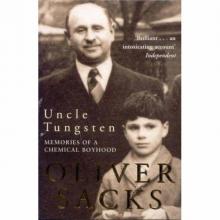 Uncle Tungsten
Uncle Tungsten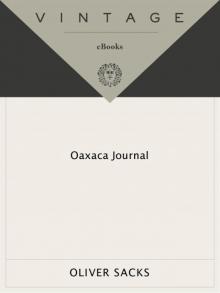 Oaxaca Journal
Oaxaca Journal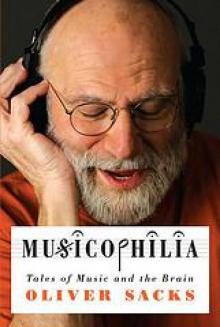 Musicophilia
Musicophilia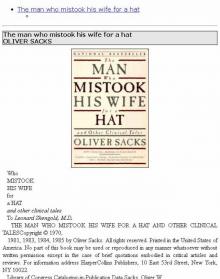 The man who mistook his wife for a hat
The man who mistook his wife for a hat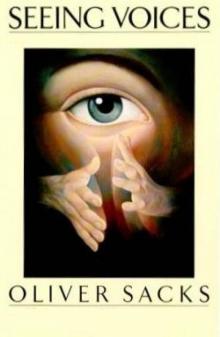 1989 - Seeing Voices
1989 - Seeing Voices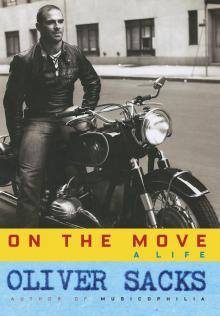 On the Move: A Life
On the Move: A Life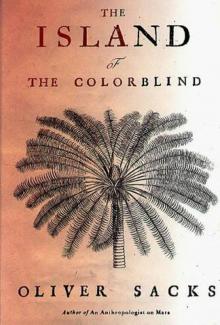 1996 - The Island of the Colorblind
1996 - The Island of the Colorblind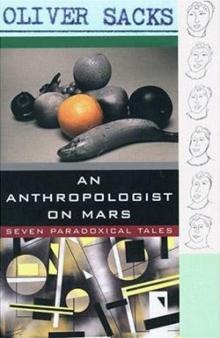 An Anthropologist on Mars: Seven Paradoxical Tales
An Anthropologist on Mars: Seven Paradoxical Tales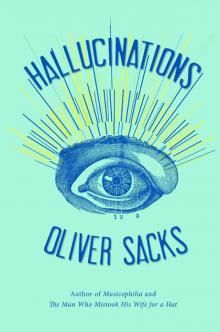 Hallucinations
Hallucinations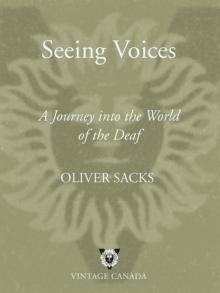 Seeing Voices
Seeing Voices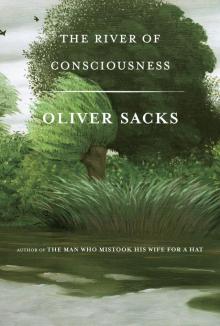 The River of Consciousness
The River of Consciousness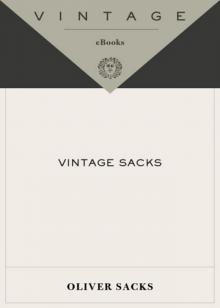 Vintage Sacks
Vintage Sacks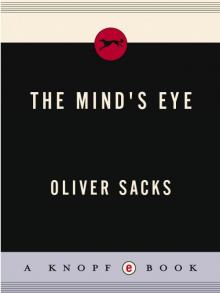 The Mind's Eye
The Mind's Eye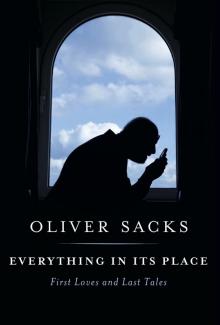 Everything in Its Place
Everything in Its Place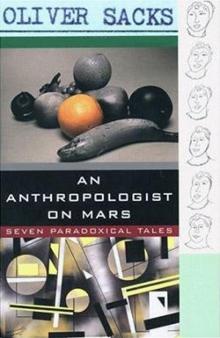 An Anthropologist on Mars (1995)
An Anthropologist on Mars (1995)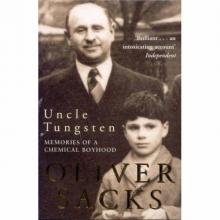 Uncle Tungsten: Memories of a Chemical Boyhood (2001)
Uncle Tungsten: Memories of a Chemical Boyhood (2001)